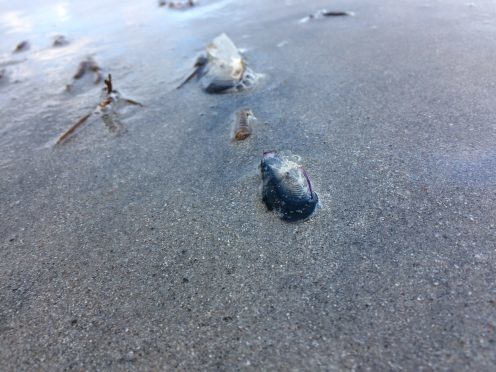Small jellyfish-like creatures that can turn a beach blue have been washed up in the Outer Hebrides by storms Barbara and Conor.
The Velella velella, known commonly as By-the-wind Sailors, have been left high and dry on the tidal island of Baleshare at North Uist as a result of the strong winds.
But unlike their poisonous cousins – Portuguese man o’ war – the Velella velella are harmless to humans.
The creatures, which are around two inches long, are pleustonic meaning they live partly in and partly out of the water.
They have a “sail” which they use to travel across oceans, and their tentacles dangle below the water to catch their prey, mostly microscopic plankton.
They are at the mercy of prevailing winds and can be subject to mass strandings on beaches, particularly in America. Contrary to popular belief, Velella velella are not jellyfish, but instead belong to the Cnidaria species.
They offer no threat to humans. They do sting but it is mild.
Velella velella are deep blue or purple in colour and often cause confusion if they wash in, in vast numbers, creating a blue beach.
The Outer Hebrides, in contrast, are noted for their pristine white sands.
By-the-wind Sailors float on the surface of the sea and through the use of their triangular sail can travel thousands of miles from the Pacific and Atlantic Ocean to UK coastlines.
Small numbers of the creatures were found on Boxing Day at Baleshare and it is believed they may have come ashore elsewhere along the islands’ chain.
In December last year, thousands of Velella velella were washed up on the south coast of Britain after being blown in by Storm Desmond.
They were spotted on Bournemouth beach and in other Dorset resorts.
Experts said it had been the biggest influx of the marine creatures in a decade – and had left beachgoers fearing for their safety due to their close resemblance to Portuguese man o’ war.
